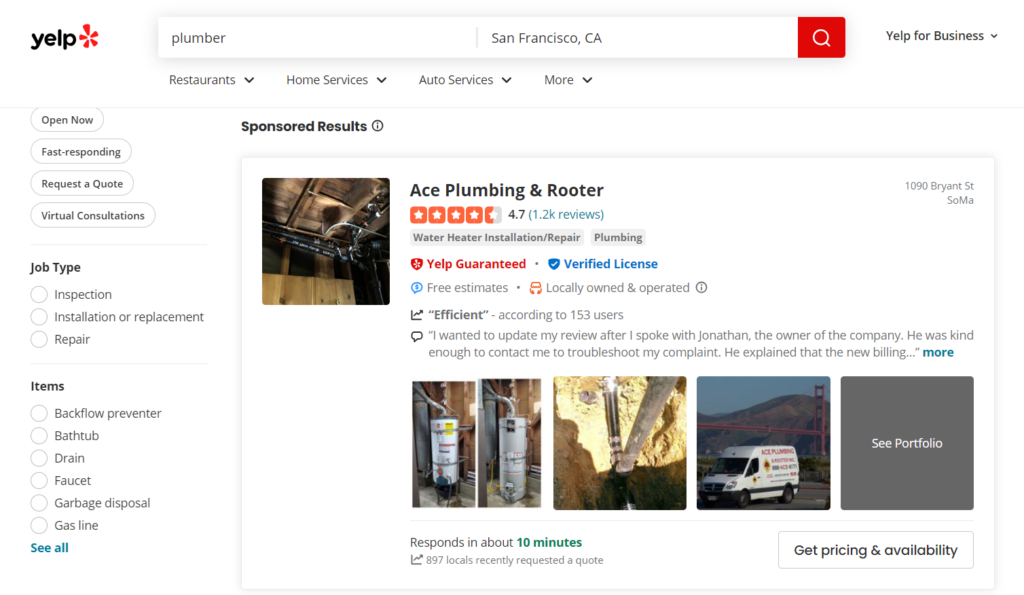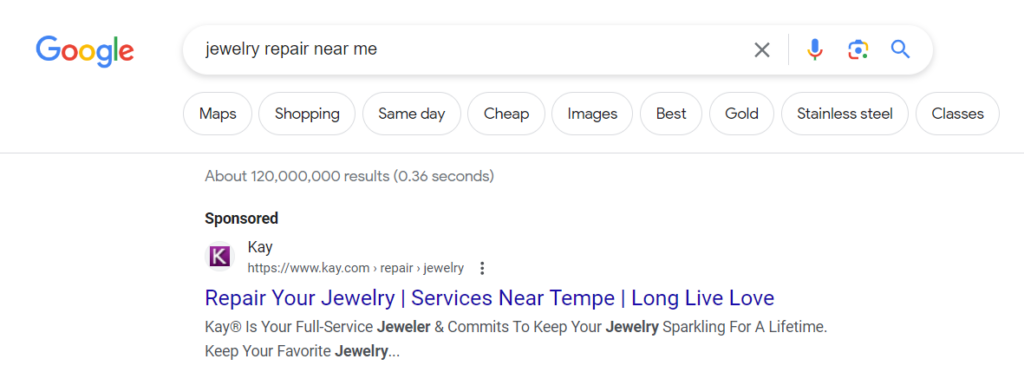Online marketing and advertising: how online ads work
The World Wide Web has become a gathering place for people across the globe. In fact, the average internet user spends over six hours online per day—nearly as long as a typical workday—which shows the growing power of the web.
As customers pay more attention to digital content, successful brands continue shifting their marketing strategies to the internet. Online marketing and advertising are more crucial than ever, especially for small businesses that want to get the best return on investment (ROI) from their marketing efforts. To that end, learn how online ads work and how to use them to your advantage.

What are online marketing and advertising?
Online marketing and advertising are two strategies that use web-based channels to promote a brand, product, or service. These digital channels can include search engines, online business platforms like Yelp, email, and social media platforms like LinkedIn and TikTok.
Online advertising specifically involves paid promotions, in which companies purchase ad space to reach a defined target audience. When you run online ad campaigns—which typically last a limited period of time—you can rapidly increase web traffic, boost brand awareness, and even drive sales.
Why is online advertising effective?

Online advertising is effective because it gets more of the right people to pay attention to your marketing message. It allows you to get very specific with who you want to reach based on demographics (like age and income), interests, and more characteristics. Every cent of your online ad budget can help you reach shoppers who are most likely to buy from your business. Conversely, traditional advertising, such as billboards and radio ads, require you to pay to reach a mass audience, which can hinder your ROI.
Online advertising can also help you reach highly engaged audiences who are ready to take action. In fact, 89% of social media users have made a purchase from a brand they follow, and 83% of users hire or buy from a business they found on Yelp. By comparison, 66% of American and Canadian viewers don’t pay attention to TV ads—and nearly the same percentage grab their phones during a commercial break.
Turning modern shoppers—who are connected to the web through smartphones, tablets, laptops, and other devices—into your new customers means prioritizing digital ad formats in your marketing strategy.
How does online advertising work?
Online ads can be leveraged by any business owner or marketer, no matter their experience level. To get started, it’s important to know the basics of online advertising—including how ad placements, targeting, and bidding work, and how to leverage analytics to improve your campaigns.
Ad placement
You might be wondering where online ads show up when you run them. The answer depends on the exact ad format you’re using, but they typically appear in prominent locations on your target audience’s screens. For example:
- Social media ads can appear on user feeds and as sponsored posts on influencer pages on social networks like Facebook, LinkedIn, and Instagram
- Video advertisements can stand alone or appear before or during a video on platforms like YouTube and Facebook
- Banner ads (or display ads) appear on the top or side of a web page
- Yelp Ads appear above or below relevant search results in the “Sponsored Results” sections of Yelp.com and the Yelp mobile app, as well as on your competitors’ pages
- Search advertisements usually appear above search engine results pages (SERPs) for relevant keywords on platforms like Google, Bing, and Yahoo
- Audio ads appear between songs and before or during podcasts on platforms like Spotify and Pandora
- Shopping ads appear as product listings above search results on e-commerce marketplaces like Amazon
Different ad placements can work for different brands. Think about the platforms your audience will most likely use and start experimenting with the tools and features of those apps or websites.
Targeting

One of the biggest advantages of online ads is their targeting capabilities. No matter how broad or specific you want to get, you may be able to customize your target audience based on characteristics like:
- Demographics: Statistical data such as age, gender, education, income, occupation, ethnicity, and marital status
- Location: The region users are currently located in, whether it’s an entire country or state or a specific city or ZIP code
- Interests: Topics your users engage with or are searching for
- Activity: Your audience’s behavior, such as their past actions on the platform or the mobile device they’re using
Some online marketing and advertising platforms also support retargeting, which involves reaching people who previously visited your website, app, or profile or purchased from your brand. To leverage retargeting, you may need to add a snippet of code to your website or app that enables the advertising platform to track visitors. You might also be able to provide an email list to reach customers who browse but don’t buy.
Targeting isn’t just beneficial for helping you reach your target market. It can also help you tailor your online ad campaigns to your specific audience. This is critical at a time when 71% of consumers expect personalized interactions with brands. Consider building buyer personas—profiles representing different segments of your target audience—before you run ads. This will help you gain a deeper understanding of your potential customers’ needs and motivations so you can cater your online marketing and advertising messages to them.
Bidding
Most online advertising platforms follow a pay-per-click (PPC) pricing model, which means you only pay when users engage with your campaign—for instance, by clicking on your link, tapping a call button, or performing another desired action on your ad. Your exact cost per click (CPC) will depend on how much you “bid” for the ad space.
So how does bidding work?
Many online advertising platforms allow you to set the maximum amount you’re willing to pay per click from your target audience, though you’ll only need to pay the amount required to win the auction. For example, if you bid $8 but the next highest bidder only bids $5.50, you’ll only need to pay $5.51 per click.
Bidding algorithms usually consider the quality and relevancy of your ads too. While a high bid might win you ad space, irrelevant content—for instance, a search ad that leads to a dog food landing page when bidding for the keyword “pet grooming”—could cause your ad to show up below competitor pages. This shows the importance of developing strong ad content versus simply spending more.
Calculating your maximum CPC
There are many ways to determine how much to bid on PPC ads. However, businesses often consider three key metrics:
- Customer lifetime value (CLV): The total revenue you earn from a typical customer throughout their relationship with your business
- Conversion rate: The average percentage of users who become sales leads—perhaps by providing their email or phone number for SMS (text messages)—after clicking on your ads
- Lead conversion rate: The average percentage of leads who become customers
Multiplying these three metrics can help you avoid overspending on your online advertising campaigns. For example, if your CLV is $1,000, your conversion rate is 5%, and your lead conversion rate is 15%, you could use the following calculation:
1000 x 0.05 x 0.15 = 7.5
In this scenario, your maximum bid should be $7.50. Recalculating your maximum CPC once per quarter can help ensure you break even, even as your CLV and conversion rates change over time.
Online ad metrics

Effective digital ad campaigns are designed and refined with real-time data in mind. Whereas traditional ad channels make it difficult to track how people are engaging with ads—and how many ad viewers buy from your brand—online marketing and advertising channels make it simple to track key metrics for ad performance.
Common online ad metrics you can track include:
- Impressions: How many times your ad was displayed to users. This can greatly impact brand awareness, even if users don’t click on your ad.
- Engagement rate: Percentage of viewers who interact with your ad, whether it’s through link clicks, comments, profile visits, likes, or another action.
- Click-through rate (CTR): Percentage of viewers who click on your ad.
- Conversion rate: Percentage of users who become leads or customers (depending on the goal of your advertisement) after viewing your campaign.
- Cost per click (CPC): The dollar amount you pay for every click.
Ad platforms may also provide data about the characteristics of the audience you’re reaching, which you can compare with those of the audience you’re targeting.
So how can you best use these online ad metrics?
Regularly review your data to inform your advertising strategy, whether you want to refine a current ad or create a brand-new campaign. For instance, if you realize your CTR is lower than usual, you can experiment with changing your call to action (CTA)—perhaps by turning “visit our website” into a more intriguing and specific “get free insights” or “save money now.” If you see your engagement rate dropping, consider A/B testing and updating different elements, like adding more visuals to your ad so it catches the eyes of more users.
Digital advertising examples

When potential customers scroll online, they see a lot of digital marketing content on their feeds. Building an effective internet advertising strategy requires you to design standout campaigns that captivate the people you want to reach. Take a look at these examples to learn how you can use different types of online advertising to engage your target market.
1. Social media advertising
The following Facebook ad, which leverages a standard image-based ad format, shows the power of eye-catching visuals and humor in social media marketing campaigns. EveryPlate, a meal kit subscription brand, uses its bright brand colors and emojis to tell a story with minimal text, which aligns with how users post and interact on the platform. The CTAs—including “Get $1 Steak for Life” and the “Get Offer” button—are clear, concise, and specific, making it easy for users to understand the product’s value and the next step to take.

However, this isn’t the only type of ad available on social media platforms. Channels like Facebook and LinkedIn also offer video ads, lead gen ads (which allow users to submit their contact info without leaving the platform), and other ad formats. Carousel ads that display multiple images for users to scroll through can also be highly engaging and, as a result, effective.
The following ad—which promotes The Farmer’s Dog, a premium human-grade dog food brand—is a great example of both a carousel ad and influencer marketing. The company enlisted a popular pet influencer page to promote its products, displaying the product next to the golden retrievers’ faces while keeping the company’s brand message front and center.

2. Advertising on Yelp
Did you know businesses that run Yelp Ads get 2.5 times more leads? The following example shows how Yelp Ads appear prominently above or below search results—in this case, for the keyword “plumber” in San Francisco—ensuring target customers see the campaign before or after competitor pages. This online ad uses a clear “Get pricing & availability” call-to-action button, which lets users enter their contact information and details about their plumbing needs without leaving Yelp.

What makes this ad even more effective is its fully filled out Yelp Business Page. It has high-quality images to represent its work and brand, clear business categories selected, and even a Verified License badge that shows why users should trust its plumbing services—all of which can be displayed to attract clients in the final ad.
Data shows that businesses with a photo, website, phone number, and business hours listed on their Yelp Page averaged 7.6x more page views per month than businesses without that content. To run your first ad on Yelp, first claim or add your Yelp Business Page to build out your profile with this important content.
Get more leads
Reach more customers with placements on search and competitors' pages.

3. Display advertising
The display ad is the most classic form of online ad. Often taking the form of banner ads, which are displayed vertically or horizontally at the top or sides of a web page, these advertisements are highly visual and clickable, driving viewers to a website or landing page.
In the example below, Adobe Stock uses colorful imagery to catch users’ eyes while putting the company’s products and capabilities on display. The copy is brief and simple, with a clear offer and CTA, which can help capture the attention of fast-scrolling users.

The banner ad is also equipped with a tracking link, which allows the ad platform to track the number of website visits the brand receives resulting from the campaign.
4. Search engine advertising
Paid ads can be a great extension of your search engine marketing efforts. While search engine optimization (SEO)—the practice of improving your website to rank higher for the right keywords—can take months to produce results, paid ads allow you to generate more website traffic from search engines quickly. With ads, your desired web pages can appear above search results for target keywords on platforms like Bing and Yahoo.
The Google ad below—which appears for users searching “jewelry repair near me” in Tempe, Arizona—is a great example of a local ad. It caters the message to the audience by calling out the city name in the title, leads with a clear CTA, and gives insight into the brand in the description.

The Google ad also links to a landing page that is fully tailored to the needs of people seeking jewelry repair services, the relevance of which further boosts the effectiveness of the ad.
5. Video advertising
As the popularity of video grows, a wide variety of online marketing and advertising platforms—from TikTok and Facebook to YouTube and streaming websites—are now offering engaging video ads. This ad format allows you to use movement, text, audio, and visuals to your advantage, whether creating video ads to stand alone or be displayed before or during other content.
The following video ad example from cybersecurity brand Fortinet is an example of how you can create an effective ad just by using text and stock videos—no filming required. The ad was displayed as a sponsored result on the YouTube homepage and clearly explains the value and features the product provides.
You can create similar videos without prior editing experience. Modern tools like Adobe Express and Animoto can help you create high-quality video ads just by dragging and dropping visual elements and adding audio. You can even use pre-made templates to streamline your process and achieve a professional look.
Grow your business with online marketing and advertising
Online marketing and advertising platforms can help you reach highly engaged internet users around the world—and paid ads in particular can get your business in front of people who are most likely to become paying customers.
With online ad campaigns, you can target audiences based on specific characteristics, like their demographics and location, and track key metrics to ensure you’re achieving your advertising goals. At the same time, you can set the maximum amount you want to pay per click to avoid going over budget or ending up in the red.
Whether you’re advertising on social media, Yelp, search engines, or other platforms, be sure to take a look at online ad examples from other brands—especially those in your field and local area—for more content inspiration.
Want to make the most of your online marketing efforts while you’re running paid ad campaigns? Learn how to reach new customers, cultivate customer loyalty, and elevate your brand with this guide on online marketing for small business.